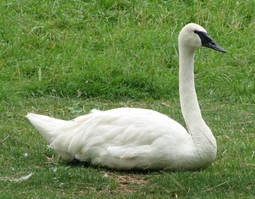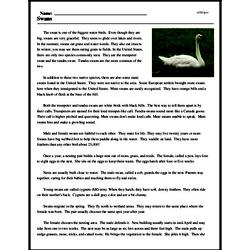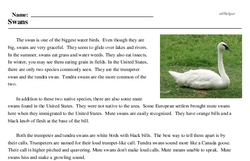Swans
The swan is one of the biggest water birds. Even though they are big, swans are very graceful. They seem to glide over lakes and rivers. In the summer, swans eat grass and water weeds. They also eat insects. In winter, you may see them eating grain in fields. In the United States, there are only two species commonly seen. They are the trumpeter swan and the tundra swan. Tundra swans are the more common of the two.
In addition to these two native species, there are also some mute swans found in the United States. They were not native to the area. Some European settlers brought mute swans here when they immigrated to the United States. Mute swans are easily recognized. They have orange bills and a black knob of flesh at the base of the bill.
Both the trumpeter and tundra swans are white birds with black bills. The best way to tell them apart is by their calls. Trumpeters are named for their loud trumpet-like call. Tundra swans sound more like a Canada goose. Their call is higher pitched and quavering. Mute swans don't make loud calls. Mute means unable to speak. Mute swans hiss and make a growling sound.
Male and female swans are faithful to each other. They mate for life. They may live twenty years or more. Swans have big webbed feet to help them paddle along in the water. They waddle on land. They have more feathers than any other bird-about 25,000!
Once a year, a nesting pair builds a huge nest out of moss, grass, and reeds. The female, called a pen, lays four to eight eggs in the nest. She sits on the eggs to keep them warm. The eggs hatch after four or five weeks.




